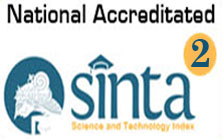The Effect of Progressive Muscle Relaxation Therapy on Anxiety in Hypertension Patients
DOI:
https://doi.org/10.31965/infokes.Vol20.Iss2.858Keywords:
Progressive Muscle Relaxation, AnxietyAbstract
Anxiety is a condition in which an individual experiences a concern about something that is not certain to happen, even some people experiencing anxiety but do not understand the specific cause of the anxiety source they feel. Anxiety problems, which are common in people, can be treated non-pharmacologically with deep muscle relaxation techniques, which do not require guided imagination or cause side effects in patients undergoing progressive muscle relaxation therapy. The objective of this study is to identify how progressive muscle relaxation techniques affected the anxiety levels of hypertension patients at the Kedaung Wetan Public Health Center. The study was conducted to determine if there was a difference in the level of anxiety experienced by hypertensive patients before and after receiving progressive muscle relaxation therapy. The design in this study employed a quasi-experimental pre-post-test with a control group with a progressive muscle relaxation therapy intervention. Result: there is a significant relationship between the period of occurrence of hypertension with anxiety experienced by respondents. Anxiety in hypertensive patients is more prevalent in those who are unfamiliar with hypertension. Thus, anxiety can arise from a sense of concern and fear of more serious complications which occur from the hypertension they are experiencing. The experimental group who received treatment in the form of progressive muscle relaxation therapy had a lower level of anxiety than the control group at the Kedaung Wetan Public Health Center in Tangerang City, with a p-value of 0.000.
Downloads
References
Atmanegara, S. P. W., & Suhita, B. M. (2021). Progressive Relaxation to Changes in Blood Pressure and Sleep Quality in Ladies of Hypertension Patients. The 3rd Joint International Conference, 3(1), 474–479. Retrieved from https://proceeding.tenjic.org/jic3/index.php/jic3/article/view/114
Bajkó, Z., Szekeres, C.-C., Kovács, K. R., Csapó, K., Molnár, S., Soltész, P., Nyitrai, E., Magyar, M. T., Oláh, L., & Bereczki, D. (2012). Anxiety, depression and autonomic nervous system dysfunction in hypertension. Journal of the Neurological Sciences, 317(1–2), 112–116. https://doi.org/10.1016/j.jns.2012.02.014
Brauer, A. P., Horlick, L., Nelson, E., Farquhar, J. W., & Stewart Agras, W. (1979). Relaxation therapy for essential hypertension: A Veterans Administration outpatient study. Journal of Behavioral Medicine, 2, 21–29. https://doi.org/10.1007/BF00846560
Carter, M. J. (2014). Diagnostic and statistical manual of mental disorders. Therapeutic Recreation Journal, 48(3), 275-277. Retrieved from https://www.proquest.com/openview/58fddc7697cee8750a87cc9d79a66e42/1?pq-origsite=gscholar&cbl=5997
Cottier, C., Shapiro, K., & Julius, S. (1984). Treatment of mild hypertension with progressive muscle relaxation: Predictive value of indexes of sympathetic tone. Archives of Internal Medicine, 144(10), 1954–1958. https://doi.org/10.1001/archinte.1984.04400010062011
Ermayani, M., Prabawati, D., & Susilo, W. H. (2020). The effect of progressive muscle relaxation on anxiety and blood pressure among hypertension patients in east Kalimantan, Indonesia. Enfermería Clínica, 30, 121–125. https://doi.org/10.1016/j.enfcli.2020.07.025
Gale, C., & Davidson, O. (2007). Generalised anxiety disorder. Bmj, 334(7593), 579–581. https://doi.org/10.1136/bmj.39133.559282.BE
Gamm, L., Stone, S., & Pittman, S. (2010). Mental health and mental disorders—A rural challenge: A literature review. Rural Healthy People, 2(1), 97–114.
Grimsrud, A., Stein, D. J., Seedat, S., Williams, D., & Myer, L. (2009). The association between hypertension and depression and anxiety disorders: results from a nationally-representative sample of South African adults. PloS One, 4(5), e5552. https://doi.org/10.1371/journal.pone.0005552
Hamrahian, S. M., & Falkner, B. (2016). Hypertension in chronic kidney disease. Hypertension: From Basic Research to Clinical Practice. Advances in Experimental Medicine and Biology, 956, 307–325.
Kementerian Kesehatan Republik Indonesia. (2017). Profil Kesehatan Indonesia Tahun 2017. Kementerian Kesehatan Republik Indonesia.
Kementerian Kesehatan Republik Indonesia. (2019). Profil Kesehatan Indonesia Tahun 2019. Kementerian Kesehatan Republik Indonesia.
Kretchy, I. A., Owusu-Daaku, F. T., & Danquah, S. A. (2014). Mental health in hypertension: assessing symptoms of anxiety, depression and stress on anti-hypertensive medication adherence. International Journal of Mental Health Systems, 8(25), 1–6. https://doi.org/10.1186/1752-4458-8-25
Lackland, D. T., & Weber, M. A. (2015). Global burden of cardiovascular disease and stroke: hypertension at the core. Canadian Journal of Cardiology, 31(5), 569–571. https://doi.org/10.1016/j.cjca.2015.01.009
Li, Y., Wang, R., Tang, J., Chen, C., Tan, L., Wu, Z., Yu, F., & Wang, X. (2015). Progressive muscle relaxation improves anxiety and depression of pulmonary arterial hypertension patients. Evidence-Based Complementary and Alternative Medicine, 2015 (792895), 1-8. https://doi.org/10.1155/2015/792895
Mawardika, T., Aniroh, U., & Lestari, P. (2020). Penerapan relaksasi otot progresif terhadap penurunan kecemasan ibu post partum. Jurnal Keperawatan, 12(2), 277–286. Retrieved from http://journal.stikeskendal.ac.id/index.php/Keperawatan/article/view/726
Nova, R. R., & Tumanggor, R. D. (2018). Pengaruh Terapi Relaksasi Otot Progresif terhadap Tingkat Kecemasan Pasien Kanker Payudara di RSUP Haji Adam Malik, Medan. Talenta Conference Series: Tropical Medicine (TM), 1(1), 59–66. Retrieved from https://talentaconfseries.usu.ac.id/tm/article/view/33
Pender, N. J. (1985). Effects of progressive muscle relaxation training on anxiety and health locus of control among hypertensive adults. Research in Nursing & Health, 8(1), 67–72. https://doi.org/10.1002/nur.4770080113
Pramono, C., Hamranani, S. S. T., & Sanjaya, M. Y. (2019). Pengaruh Teknik Relaksasi Otot Progresif terhadap Tingkat Kecemasan Pasien Hemodialisa di RSUD Wonosari. Jurnal Ilmu Keperawatan Medikal Bedah, 2(2), 22–32. https://doi.org/10.32584/jikmb.v2i2.248
Rosdiana, I., & Cahyati, Y. (2019). Effect of progressive muscle relaxation (PMR) on blood pressure among patients with hypertension. International Journal of Advancement in Life Sciences Research, 28–35. Retrieved from http://ijalsr.org/index.php/journal/article/view/48
Rowa, K., & Antony, M. M. (2008). Generalized anxiety disorder. In W. E. Craighead, D. J. Miklowitz, & L. W. Craighead (Eds.), Psychopathology: History, diagnosis, and empirical foundations (pp. 78–114). John Wiley & Sons, Inc.
Sawicka, K., Szczyrek, M., Jastrzebska, I., Prasal, M., Zwolak, A., & Daniluk, J. (2011). Hypertension–the silent killer. Journal of Pre-Clinical and Clinical Research, 5(2), 43-46.
Sheu, S., Irvin, B. L., Lin, H.-S., & Mar, C.-L. (2003). Effects of progressive muscle relaxation on blood pressure and psychosocial status for clients with essential hypertension in Taiwan. Holistic Nursing Practice, 17(1), 41–47. Retrieved from https://journals.lww.com/hnpjournal/Abstract/2003/01000/Effects_of_Progressive_Muscle_Relaxation_on_Blood.9.aspx
Shinde, N., Shinde, K. J., Khatri, S. M., & Hande, D. (2013). Immediate effect of Jacobson’s progressive muscular relaxation in hypertension. Indian Journal of Physiotherapy and Occupational Therapy, 7(3), 249-252.
Stein, M. B., & Sareen, J. (2015). Generalized anxiety disorder. New England Journal of Medicine, 373, 2059–2068. https://doi.org/10.1056/NEJMcp1502514
Thirunavurakasu, M., Thirunavukarasu, P., & Bhugra, D. (2013). Concepts of mental health: definitions and challenges. International Journal of Social Psychiatry, 59(3), 197-198. https://doi.org/10.1177/0020764011422006
Tyrer, P., & Baldwin, D. (2006). Generalised anxiety disorder. The Lancet, 368(9553), 2156–2166. https://doi.org/10.1016/S0140-6736(06)69865-6
Wei, T.-M., & Wang, L. (2006). Anxiety symptoms in patients with hypertension: a community-based study. The International Journal of Psychiatry in Medicine, 36(3), 315–322. https://doi.org/10.2190/5LX9-D3BH-FUA3-PQF0
Wells, A., & Carter, K. (2016). Generalised anxiety disorder. In The Handbook of Adult Clinical Psychology. Routledge.
World Health Organization. (2008). World Health Statistics 2008. World Health Organization.
World Health Organization. (2013). A global brief on hypertension: silent killer, global public health crisis: World Health Day 2013. World Health Organization.
Yu, J., Zhou, R., & Cai, G. (2011). From hypertension to stroke: mechanisms and potential prevention strategies. CNS Neuroscience & Therapeutics, 17(5), 577–584. https://doi.org/10.1111/j.1755-5949.2011.00264.x
Zung, W. W. K. (1971). Self-rating anxiety scale. BMC Psychiatry. https://doi.org/10.1037/t04092-000
Downloads
Published
How to Cite
Issue
Section
License
Copyright (c) 2022 JURNAL INFO KESEHATAN

This work is licensed under a Creative Commons Attribution-NonCommercial-ShareAlike 4.0 International License.
Copyright notice
Ownership of copyright
The copyright in this website and the material on this website (including without limitation the text, computer code, artwork, photographs, images, music, audio material, video material and audio-visual material on this website) is owned by JURNAL INFO KESEHATAN and its licensors.
Copyright license
JURNAL INFO KESEHATAN grants to you a worldwide non-exclusive royalty-free revocable license to:
- view this website and the material on this website on a computer or mobile device via a web browser;
- copy and store this website and the material on this website in your web browser cache memory; and
- print pages from this website for your use.
- All articles published by JURNAL INFO KESEHATAN are licensed under the Creative Commons Attribution 4.0 International License. This permits anyone to copy, redistribute, remix, transmit and adapt the work provided the original work and source is appropriately cited.
JURNAL INFO KESEHATAN does not grant you any other rights in relation to this website or the material on this website. In other words, all other rights are reserved.
For the avoidance of doubt, you must not adapt, edit, change, transform, publish, republish, distribute, redistribute, broadcast, rebroadcast or show or play in public this website or the material on this website (in any form or media) without appropriately and conspicuously citing the original work and source or JURNAL INFO KESEHATAN prior written permission.
Permissions
You may request permission to use the copyright materials on this website by writing to jurnalinfokesehatan@gmail.com.
Enforcement of copyright
JURNAL INFO KESEHATAN takes the protection of its copyright very seriously.
If JURNAL INFO KESEHATAN discovers that you have used its copyright materials in contravention of the license above, JURNAL INFO KESEHATAN may bring legal proceedings against you seeking monetary damages and an injunction to stop you using those materials. You could also be ordered to pay legal costs.
If you become aware of any use of JURNAL INFO KESEHATAN copyright materials that contravenes or may contravene the license above, please report this by email to jurnalinfokesehatan@gmail.com
Infringing material
If you become aware of any material on the website that you believe infringes your or any other person's copyright, please report this by email to jurnalinfokesehatan@gmail.com.



















